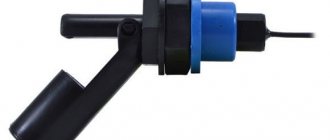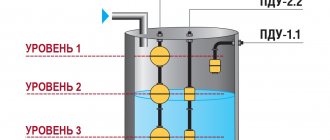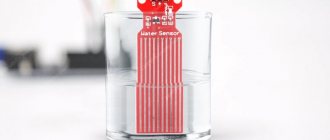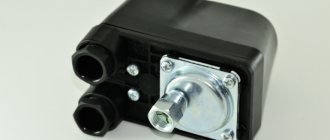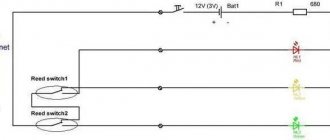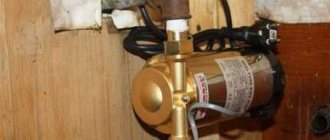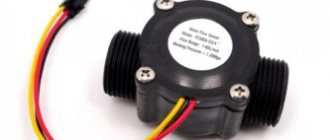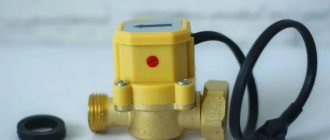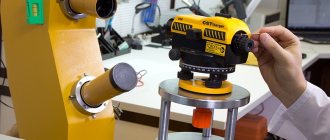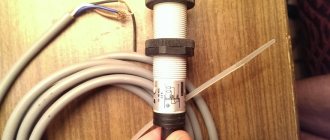For maximum automation of water supply systems, there are ready-made pumping stations. But for a number of reasons, their installation is not always justified. My neighbor in the countryside found himself in a similar situation. But he found a simple solution - he connected a water level switch to the reservoir and pump in the well. Then I decided to learn more about such a device and this is what I found out.
Source ds05.infourok.ru
How the device works
A water level sensor in the tank is installed to turn the pump on and off automatically. This can be a closed or open type container. The device is also used to monitor the situation in flooded, for example, basements. That is, it is not necessary to constantly conduct a visual inspection to timely pump out unnecessary fluid.
The principle of operation of the relay is based on a change in resistance between single-pole electrodes and other elements contained in the working environment. In addition to drinking water, this may include:
- spring, sea, river, rain or waste water;
- milk or beer;
- wine and vodka products with low alcohol content.
Not subject to control:
- distilled water;
- gasoline, kerosene and liquefied gas;
- oil and ethylene glycol.
Typically, water level sensors for pump control are installed at the lower and upper points relative to the fullness of the tank, or at the acceptable upper point in the case of a basement. The third sensor is responsible for receiving signals from the first two and for transmitting information to the pumping equipment. Since the generated pulses are too small to start and stop a relatively more powerful circuit, the switched currents are perceived by a magnetic starter.
Source kipia.ru
It is worth noting that the water level switch in the tank is not initially equipped with sensors. This is justified by the fact that the device can be operated by a different number of sensors. Including 4, where the latter is triggered in case of emergency situations. It can be useful if you use a large liquid reservoir (so that it does not overflow) or in conditions of frequent flooding of the cellar.
Types of devices
Liquid level switches for turning off the pump are now available in several versions. Single-level models are used to stably maintain a given reservoir at a given degree of fullness. This eliminates idle operation of the pumping equipment, which ensures its long-term operation.
Source euro-avtomatika.ru
Two-level samples are installed to monitor the maximum and minimum filling of the tank. That is, this is where there are three sensors. And in four-level models there are two additional alarms. They are responsible for warning about emergency situations. On an industrial scale, as a rule, backup pumping stations are connected to them. The devices are also equipped with LED indication.
Types of sensors
There are three types of elements that perceive and transmit information about changes in resistance in the working environment. The electrode water level sensor for the pump is represented by three sensors: a short one and a pair of long ones. The first is responsible for transmitting impulses when the tank is maximally full, the second - when it is empty.
Source techparts.com.ua
Float water level sensors for pump control are represented by a float with a built-in magnetic and a tube, inside of which a reed switch is located. The latter is a sealed box containing ferromagnetic contacts. They are connected to each other under the influence of a magnetic field, which is perceived at the level required for operation during the displacement of the float. And its position changes as the reservoir is emptied and filled with working fluid.
The water level float switch for the pump can also be used as a measuring device to monitor the filling level of the tank. Depending on the strength of the magnetic field, the contact pairs of the reed switch transmit signals with a resistance of 4 to 20 mA to the resistor. That is, by placing sensors at several levels, you can monitor the fullness of the tank at any time.
Source: amazon.com
The third type is a capacitive sensor. Another name for the device is a parametric water level meter. Here the principle of operation is based on a change in the dielectric constant of the working medium. A highly sensitive capacitor is responsible for detecting these changes. Air permeability is taken as the reporting unit. When the reservoir is filled with liquid, the capacity changes. This phenomenon is converted into information that is displayed on an external scale. It is worth noting that the dielectric constant can be perceived not only from the side of the water inside the tank, but also from the side of its walls. That is, such a pump control sensor for a given water level can be installed both inside and outside the tank.
Source yandex.net
This video shows one of the automatic pump control circuits using a relay using a simple example:
Ultrasonic water level sensors
According to the principle of operation and design of the device, ultrasonic sensors are similar to radar ones. Only these devices use ultrasound. Ultrasonic radiation is created using a generator. After reaching the water surface, it is reflected and reaches the sensor receiver after a certain time. The advantages can be identified as the same as in a radar device. Only the circuit design is simpler, and the indicators are not as accurate.
Level measurement methods
Monitoring the water level in the tank to control the pump can be done in two ways: contact and non-contact. That is, the sensors are located inside the tank with the working medium or outside. The first group includes float devices, hydrostatic pressure gauges or plate capacitors that are mounted on the walls of the tank. The second type of meters is represented by radar and ultrasonic devices. They are relevant when it is impossible to carry out control in close proximity to the object. The reasons may be high viscosity of the working medium, chemical aggressiveness.
Radar water level sensors
Such sensors can detect the rise of a liquid by achieving the reflected signal, comparing the frequency shift, as well as the delay between emissions. The radar sensor works as both a pickup and a reflection emitter. Such sensors are one of the most accurate, reliable and best devices.
The advantages of radar water level sensors include:
- No contact with liquid medium.
- Accuracy.
- There are no moving parts.
- Not picky about working conditions.
The only disadvantage of radar sensors is their high cost.
Electromechanical solutions
A common feature for such devices is the presence of a moving part, some type of float resting on the surface, or a device that must move through the contents.
Float - Using a float on the surface of a liquid is a simple and reliable method of measuring its level, provided that the contents do not obstruct free movement. There are a variety of valves, switches and position sensors that are float activated and provide level position recording or continuous reading over a limited range.
Some of the more modern designs for continuous float measurements use magnetostrictive sensing technology. The float is toroidal in shape and moves outside the tubular waveguide. Waveguides can be up to 50 feet (15 m) long, so they are used in very large tanks. The float contains a permanent magnet that causes the electrical pulse sent down the waveguide to be interrupted. The breakpoint is recorded with high repeatability and exceptional accuracy of ±<0.001 inch. Once the devices are installed and configured, no additional calibration is required.
“Magnetostrictive technology fits perfectly with wireless data transmission,” says Mike Geis, market development specialist for Ametek Automation & Process Technologies. “The response to the pulse is immediate, so current consumption is minimal.”
Two floats can be placed on the waveguide, making magnetostrictive measurements one of the few techniques that can provide continuous level measurements of liquid layers (such as oil on top of water) using a single instrument. “If the specific gravity differs by even 10%, we can develop special floats for level detection in multilayer liquids,” adds Geis.
Vibration and paddle wheel - These two methods are similar in that they involve immersing a moving probe into the contents. A vibration probe immersed in a material resembles a tuning fork, in which continuous vibration is created using a piezoelectric crystal. If the probe is not immersed in the contents, it vibrates freely. When diving, the nature of the vibration changes, which is recognized by the mechanism and the corresponding signal is sent.
Similarly, a paddle wheel uses a movable blade or fin-like flag mounted on a shaft attached to a small motor. When immersed in a solid product, the device cannot rotate and emits a signal. Once the contents are released, rotation resumes. Both methods use submersible sensors that are subjected to the destructive effects of the tank contents.
Pressure - Similar to mass measurements (tank weighing), pressure or differential pressure methods determine the level by measuring the head at the bottom of the tank (or where the instrument is located). If the tank is exposed to the atmosphere, you can get by with a regular pressure gauge. However, if the tank is closed and under pressure or is being pumped out, the reading of the differential pressure between the bottom and the free space in the upper part of the tank is used to automatically compensate for the difference in internal and atmospheric pressure. This method works well, but requires additional piping.
How to make it yourself
To create a simple level meter, you will need an HC-SR04 ultrasonic module and an 8051 microcontroller. The device allows you to control the liquid level in a tank up to 2 meters deep. To operate the device, you need to isolate the NS-SR04 from moisture.
HC-SR04 is installed at the top of the tank, with the emitter facing the liquid. Ultrasonic vibrations emitted by the module are reflected from the surface of the water. The receiver receives the echo signal, calculates the time delay and transmits the generated signal about the measurement results to the microcontroller.
The microcontroller reads the signal and calculates the distance.
When you enter the required program, the microcontroller will turn on the pump when the water level drops to the minimum set value, and turn it off when the maximum level is reached.
Design and principle of operation
Regardless of what principle of operation is the basis of the device, whether it operates only in alarm mode or simultaneously performs the functions of a watchman, automatic machine or control mechanism, the design of the device always consists of three main components:
- A sensing element capable of responding to the characteristics of the water flow. For example, the actual presence of water, the height of the column or level in the tank, the fact of the movement of water flow in a pipe or line;
- A ballast element that balances the sensor part of the sensor. Without ballast, the sensitive sensor would be triggered by the slightest shock or stray drop of water;
- The transmitting or actuating part that converts the signal from the sensor built into the water sensor into a specific signal or action.
Approximately 90% of all water equipment is, in one way or another, connected to electrical actuators - pumps, valves, heaters and electronic control machines. It is clear that such a device working with water flows must first of all be safe.
Of all the alarm systems, the sensor that monitors the state of water is considered the simplest and most accessible to set up and repair. Unlike sensors and devices that work with temperature, pressure or flow measurements, a water sensor is very easy to control using simple devices, or, in extreme cases, see the level or pumped flow with your own eyes.
Electrical probes
In cases where it is possible to limit oneself to discrete level measurement and contact with the product is allowed, the use of capacitive and conductive probes becomes a simple and reliable solution to the problem.
Conductive probes are simple and provide level readings for conductive liquids. They are often mounted in a block of two or more to measure the upper and lower levels. If the liquid is not electrically conductive, a different approach must be used.
Capacitance probes detect the presence of solid or liquid contents by varying the capacitance of a probe equipped with multiple electrodes. A high frequency current is applied to the electrodes, and its change, due to the dielectric properties of the contacting substance, can be measured. Some designs provide the ability to determine the dielectric constant of a product, making it possible to differentiate between different contents. For example, the readings of a probe immersed in oil differ from those when it is immersed in water. This can help in situations where there is more than one product in the tank.
Some capacitive sensors provide reading through the wall of a non-metallic tank, allowing the position of the level to be determined without entering the tank or contacting the product. The sensor can be mounted on a flat tank wall or wrapped around a non-metallic pipe. If the tank is made of metal, the sensor can be placed on an inspection window or in a well made of plastic pipe. “Capacitive sensors work great with most bulk materials,” says Roger Saba, product manager at Turck Instrumentation Group. “Some heterogeneous materials, such as chlorine-containing detergents, form a coating inside the tank and change the characteristics of the plastics. Capacitive sensors tend to get blocked and give false readings, but more advanced devices have successfully overcome this problem.”
Thermal probes are immersed in the tank. They use a small heating element to heat the tip; the temperature increase is measured. If there is no liquid around the probe, the temperature increase can be relatively large. However, in the presence of liquid, heat is dissipated and the probe heats up to a lesser extent.
Selection of methodology
One of the simplest and most reliable ways to determine the level of filling of a tank is to weigh it. This is the only method that gives the true mass regardless of whether the internal dimensions of the tank are known. The degree of filling of the tank can be determined using strain gauges placed under its support, subtracting its own weight. This method is suitable for any type of content and, provided there is no interference from piping or other connections, can provide highly accurate measurements. There are practical restrictions on overall overall dimensions, but this obvious solution cannot be overlooked.
If its use turns out to be impractical, one will have to resort to other, much more complex solutions, the applicability of which depends on a combination of various requirements.
The most common criterion when choosing a level measurement technique is the contents of the tank. For the purposes of this discussion, we define liquids as substances that settle at a uniform level and have the ability to flow through pipes. A solid-phase substance may have the same degree of fluidity, but does not necessarily form a uniform surface, nor does it flow down the walls of the vessel. The behavior of liquids with significant viscosity or a high solids content is more typical of bulk solids.
Below is a brief description of level measurement methods. Compare them based on the intended applications shown in the sidebar. Consider that continuous methods can be used to perform functions defined by a discrete level position, and a collection of point level measurements can be treated as continuous data, which can be useful despite their approximate nature. Both the list of applications and the overview of techniques are not exhaustive. For each application, there are methods that are not mentioned, and for each general case, justified exceptions are possible.
Nuclear (radiation) sensors
Despite the high efficiency of this solution, it remains a method that is used last, due to its high cost and specialized requirements. The method is very simple: a radioactive source of gamma radiation is placed on one side of the tank. On the other side, sensors similar to a Geiger counter are mounted to read the level. The contents of the tank, solid or liquid, absorb gamma rays in a predictable manner, allowing the level to be determined electronically. The accuracy of the measurements is determined by the number of sensors, so this method is usually used to record the upper and lower limits.
Radiation sensors do not require penetration into the volume of the product, or even into the tank at all, so this method is especially valuable for installations with high pressure and temperature, when processing expensive products, and also when it is impractical to rework existing equipment. However, given the radioactive source's ability to radiate through a typical steel tank, handling it will require special permits and operator training, so this technical solution requires careful consideration and preparation.
